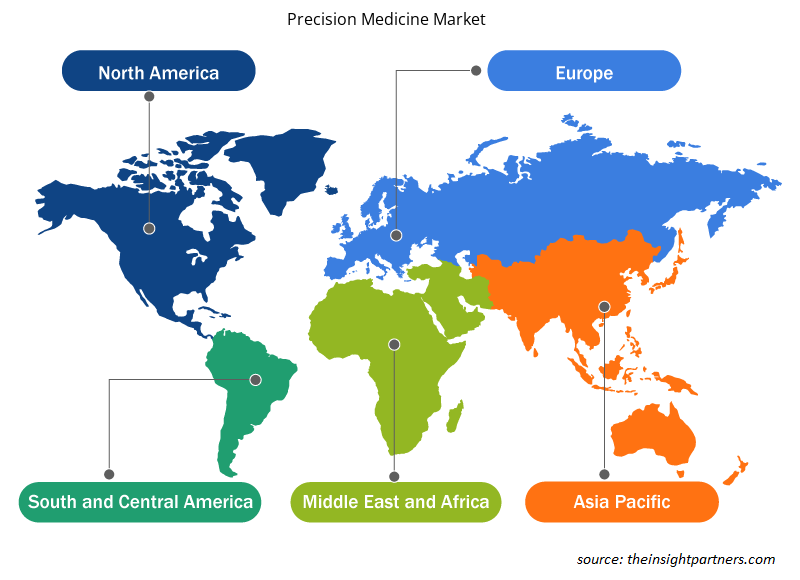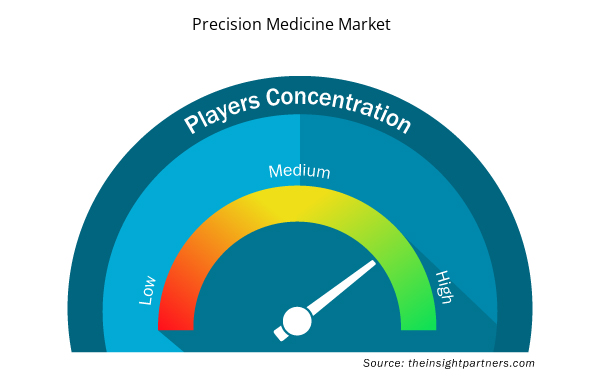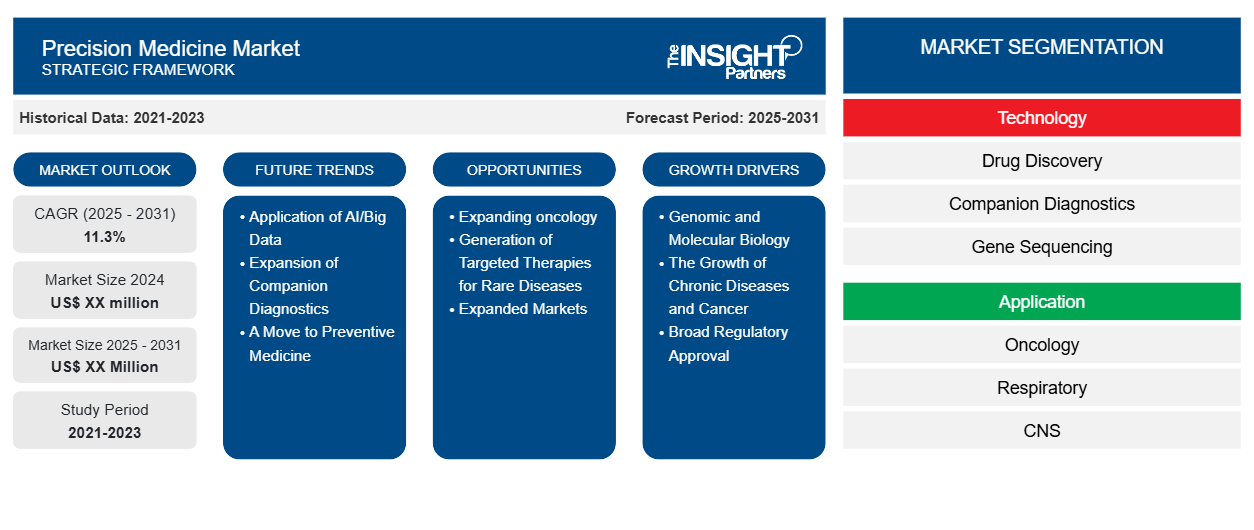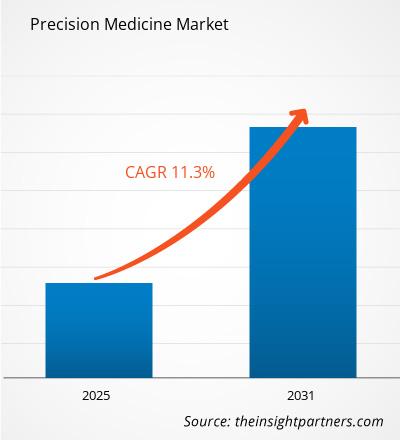Es wird erwartet, dass der Markt für Präzisionsmedizin von 2024 bis 2031 eine durchschnittliche jährliche Wachstumsrate (CAGR) von 11,3 % verzeichnet, wobei die Marktgröße von XX Millionen US-Dollar im Jahr 2024 auf XX Millionen US-Dollar im Jahr 2031 anwachsen wird.
Der Markt für Präzisionsmedizin ist nach Technologie in die folgenden Untersegmente unterteilt: Arzneimittelforschung, Begleitdiagnostik, Gensequenzierung, Bioinformatik, Big Data Analytics. Darüber hinaus wird eine Analyse basierend auf der Anwendung präsentiert, d. h. Onkologie, Atemwege, ZNS, Infektionskrankheiten, Immunologie, Kardiologie, andere Anwendungen. Die globale Analyse ist auf regionaler Ebene und in den wichtigsten Ländern aufgeschlüsselt. Die Marktbewertung wird für die obige Segmentanalyse in US-Dollar angegeben.
Zweck des Berichts
Der Bericht „Markt für Präzisionsmedizin“ von The Insight Partners soll die aktuelle Landschaft und das zukünftige Wachstum sowie die wichtigsten treibenden Faktoren, Herausforderungen und Chancen beschreiben. Dies wird verschiedenen Geschäftspartnern Einblicke geben, wie zum Beispiel:
- Technologieanbieter/-hersteller: Um die sich entwickelnde Marktdynamik zu verstehen und die potenziellen Wachstumschancen zu kennen, damit sie fundierte strategische Entscheidungen treffen können.
- Investoren: Durchführung einer umfassenden Trendanalyse hinsichtlich der Marktwachstumsrate, der finanziellen Marktprognosen und der Chancen entlang der Wertschöpfungskette.
- Regulierungsbehörden: Zur Regulierung von Richtlinien und Überwachungsaktivitäten auf dem Markt mit dem Ziel, Missbrauch zu minimieren, das Vertrauen der Anleger zu bewahren und die Integrität und Stabilität des Marktes aufrechtzuerhalten.
Marktsegmentierung für Präzisionsmedizin
Technologie
- Arzneimittelforschung
- Begleitdiagnostik
- Gensequenzierung
- Bioinformatik
- Big Data-Analyse
Anwendung
- Onkologie
- Atemwege
- ZNS
- Infektionskrankheiten
- Immunologie
- Kardiologie
- Andere Anwendungen
Passen Sie diesen Bericht Ihren Anforderungen an
Sie erhalten kostenlos individuelle Anpassungen an jedem Bericht, einschließlich Teilen dieses Berichts oder einer Analyse auf Länderebene, eines Excel-Datenpakets sowie tolle Angebote und Rabatte für Start-ups und Universitäten.
- Holen Sie sich die wichtigsten Markttrends aus diesem Bericht.Dieses KOSTENLOSE Beispiel umfasst eine Datenanalyse von Markttrends bis hin zu Schätzungen und Prognosen.
Wachstumstreiber auf dem Markt für Präzisionsmedizin
- Genom- und Molekularbiologie: Genom- und Molekularbiologie sind die Motoren der Präzisionsmedizin. Die Sequenzierung und Interpretation von genetischem Material führte zu personalisierten Behandlungen, bei denen die Therapien anhand des genetischen Codes, des Lebensstils und der Umwelt individualisiert werden. Ein zunehmendes Bewusstsein für das menschliche Genom eröffnet neue therapeutische Anwendungen für die Präzisionsmedizin in der Onkologie, bei seltenen Krankheiten und chronischen Erkrankungen.
- Die Zunahme chronischer Krankheiten und Krebs: Die Zunahme chronischer Krankheiten wie Krebs, Herz-Kreislauf-Erkrankungen, Diabetes usw. treibt die Präzisionsmedizin voran. Je mehr Patienten auf der Grundlage ihrer eigenen genetischen Merkmale behandelt werden möchten, desto mehr werden personalisierte Behandlungen und genetische Tests benötigt, die zu besseren Behandlungsergebnissen für die Patienten führen könnten.
- Breite behördliche Zulassung: Regierungen wie die FDA und die EMA sind der Präzisionsmedizin gegenüber aufgeschlossener geworden und erlauben gezielte Behandlungen und Begleitdiagnostik, um maßgeschneiderte Behandlungspläne zu ermöglichen. Diese behördlichen Zulassungen treiben nicht nur den Fortschritt der Präzisionsmedizin voran, sondern geben auch Anlass, hinsichtlich ihrer klinischen Anwendung optimistisch zu sein.
Zukünftige Trends auf dem Markt für Präzisionsmedizin
- Anwendung von KI/Big Data: Künstliche Intelligenz (KI) und Big Data verändern die Präzisionsmedizin. Die Algorithmen der KI untersuchen Patientendaten – Genomik, Krankenakten, Bilddaten –, um Muster zu finden und Patientenergebnisse vorherzusagen. Dies treibt auch die Einführung der Präzisionsmedizin in der Klinik voran.
- Ausbau der Begleitdiagnostik: Begleitdiagnostik, also Testergebnisse, die bestimmen, wie ein Patient auf eine bestimmte Therapie reagiert, nimmt zu. Da immer präzisere Behandlungen entwickelt werden, nutzt die Präzisionsmedizin Begleitdiagnostik als Orientierung für die Therapieauswahl. Dieses Muster sehen wir in der Onkologie, wo eine Reihe von Mutationen und Biomarkern die wirksamsten Therapien bestimmt.
- Ein Schritt in Richtung Präventivmedizin: Bei der Präzisionsmedizin geht es nicht nur um die Diagnose, sondern auch um die Vorbeugung von Krankheiten. Wenn genetische Risikofaktoren im Voraus erkannt werden, können Ärzte präventive Maßnahmen individuell anpassen. Diese Revolution der Prävention und Nachbehandlung ist ein weit verbreitetes medizinisches Phänomen, insbesondere bei Krebs, Herzkrankheiten und seltenen genetischen Erkrankungen.
Marktchancen für Präzisionsmedizin
- Ausbau der Onkologie: Die Präzisionsonkologie ist eine der größten Entwicklungen in der Präzisionsmedizin. Zielgerichtete Krebstherapien, die auf der Grundlage genetischer Mutationen und Biomarker entwickelt werden können, verändern die Krebstherapie. Die Zahl der von der FDA zugelassenen Medikamente für die Präzisionsonkologie steigt, und es gibt enorme Marktchancen für genetische Tests, die Entdeckung von Biomarkern und individualisierte Krebstherapien.
- Entwicklung gezielter Therapien für seltene Krankheiten: Präzisionsmedizin ist vielversprechend für seltene genetische Krankheiten, für die es derzeit keine Behandlungsmöglichkeiten gibt. Das genetische Profil eines Patienten ermöglicht die Entwicklung einer maßgeschneiderten Therapie, die den Patienten dauerhafte Linderung dieser unerfüllten Bedürfnisse bietet.
- Erweiterte Märkte: Die Präzisionsmedizin breitet sich nicht nur in entwickelten Märkten aus, sondern auch in Schwellenmärkten. Die Präzisionsmedizin wird weiter wachsen, da sich die Gesundheitssysteme im asiatisch-pazifischen Raum und in Lateinamerika weiterentwickeln und in die modernsten Technologien investieren, wodurch neue Umsatzmöglichkeiten für Diagnostikunternehmen, Pharma- und Biotech-Unternehmen erschlossen werden.
Regionale Einblicke in den Markt für Präzisionsmedizin
Die regionalen Trends und Faktoren, die den Markt für Präzisionsmedizin im gesamten Prognosezeitraum beeinflussen, wurden von den Analysten von Insight Partners ausführlich erläutert. In diesem Abschnitt werden auch die Marktsegmente und die Geografie des Präzisionsmedizinmarkts in Nordamerika, Europa, im asiatisch-pazifischen Raum, im Nahen Osten und Afrika sowie in Süd- und Mittelamerika erörtert.

- Holen Sie sich regionale Daten zum Markt für Präzisionsmedizin
Umfang des Marktberichts zur Präzisionsmedizin
| Berichtsattribut | Details |
|---|---|
| Marktgröße im Jahr 2024 | XX Millionen US-Dollar |
| Marktgröße bis 2031 | XX Millionen US-Dollar |
| Globale CAGR (2025 - 2031) | 11,3 % |
| Historische Daten | 2021-2023 |
| Prognosezeitraum | 2025–2031 |
| Abgedeckte Segmente | Nach Technologie
|
| Abgedeckte Regionen und Länder | Nordamerika
|
| Marktführer und wichtige Unternehmensprofile |
|
Dichte der Marktteilnehmer für Präzisionsmedizin: Deren Auswirkungen auf die Geschäftsdynamik verstehen
Der Markt für Präzisionsmedizin wächst rasant. Dies wird durch die steigende Nachfrage der Endnutzer aufgrund von Faktoren wie sich entwickelnden Verbraucherpräferenzen, technologischen Fortschritten und einem größeren Bewusstsein für die Vorteile des Produkts vorangetrieben. Mit der steigenden Nachfrage erweitern Unternehmen ihr Angebot, entwickeln Innovationen, um die Bedürfnisse der Verbraucher zu erfüllen, und nutzen neue Trends, was das Marktwachstum weiter ankurbelt.
Die Marktteilnehmerdichte bezieht sich auf die Verteilung der Firmen oder Unternehmen, die in einem bestimmten Markt oder einer bestimmten Branche tätig sind. Sie gibt an, wie viele Wettbewerber (Marktteilnehmer) in einem bestimmten Marktraum im Verhältnis zu seiner Größe oder seinem gesamten Marktwert präsent sind.
Die wichtigsten auf dem Markt für Präzisionsmedizin tätigen Unternehmen sind:
- F. Hoffmann-La Roche Ltd
- Quest Diagnostics GmbH
- Novartis AG
- Bristol-Myers Squibb Company
- Medtronic
Haftungsausschluss : Die oben aufgeführten Unternehmen sind nicht in einer bestimmten Reihenfolge aufgeführt.

- Überblick über die wichtigsten Akteure auf dem Markt für Präzisionsmedizin
Wichtige Verkaufsargumente
- Umfassende Abdeckung: Der Bericht deckt die Analyse von Produkten, Dienstleistungen, Typen und Endbenutzern des Marktes für Präzisionsmedizin umfassend ab und bietet einen ganzheitlichen Überblick.
- Expertenanalyse: Der Bericht basiert auf dem umfassenden Verständnis von Branchenexperten und Analysten.
- Aktuelle Informationen: Der Bericht stellt durch die Abdeckung aktueller Informationen und Datentrends Geschäftsrelevanz sicher.
- Anpassungsoptionen: Dieser Bericht kann angepasst werden, um spezifische Kundenanforderungen zu erfüllen und die Geschäftsstrategien optimal anzupassen.
Der Forschungsbericht zum Markt für Präzisionsmedizin kann daher dabei helfen, die Branchensituation und Wachstumsaussichten zu entschlüsseln und zu verstehen. Obwohl es einige berechtigte Bedenken geben kann, überwiegen die allgemeinen Vorteile dieses Berichts tendenziell die Nachteile.
- Historische Analyse (2 Jahre), Basisjahr, Prognose (7 Jahre) mit CAGR
- PEST- und SWOT-Analyse
- Marktgröße Wert/Volumen – Global, Regional, Land
- Branche und Wettbewerbsumfeld
- Excel-Datensatz


- Space Situational Awareness (SSA) Market
- Artificial Intelligence in Healthcare Diagnosis Market
- Small Molecule Drug Discovery Market
- Vision Care Market
- Fertilizer Additives Market
- Dropshipping Market
- Virtual Production Market
- Energy Recovery Ventilator Market
- Mail Order Pharmacy Market
- Dried Blueberry Market

Report Coverage
Revenue forecast, Company Analysis, Industry landscape, Growth factors, and Trends

Segment Covered
This text is related
to segments covered.

Regional Scope
North America, Europe, Asia Pacific, Middle East & Africa, South & Central America

Country Scope
This text is related
to country scope.
Häufig gestellte Fragen
Some of the customization options available based on request are additional 3-5 company profiles and country-specific analysis of 3-5 countries of your choice. Customizations are to be requested/discussed before making final order confirmation, as our team would review the same and check the feasibility.
The report can be delivered in PDF/PPT format; we can also share excel dataset based on the request.
The leading players are F. Hoffmann-La Roche Ltd, Quest Diagnostics Incorporated, Novartis AG, Bristol-Myers Squibb Company, Medtronic, QIAGEN, Pfizer Inc., Thermo Fisher Scientific Inc., Eli Lilly and Company, AstraZeneca,
The market is expected to register a CAGR of 11.3% during 2023-2031.
Rapidly rising healthcare expenditure, advancement in genetic testing, migration towards personalized treatments, and integration of big data and AI in healthcare are the prime growth factors for Precision Medicine Market.
Future trends include increased use of genomic data in developing tailored treatments, expansion of personalized cancer therapies, and increased integration of AI and machine learning in drug development.
Trends and growth analysis reports related to Life Sciences : READ MORE..
The List of Companies
1. F. Hoffmann-La Roche Ltd
2. Quest Diagnostics Incorporated
3. Novartis AG
4. Bristol-Myers Squibb Company
5. Medtronic
6. QIAGEN
7. Pfizer Inc.
8. Thermo Fisher Scientific Inc.
9. Eli Lilly and Company
10. AstraZeneca
11. OneOme LLC
12. Kailos Genetics Inc.
13. Syapse Inc.
14. BioSyntagma
15. Biogen
The Insight Partners performs research in 4 major stages: Data Collection & Secondary Research, Primary Research, Data Analysis and Data Triangulation & Final Review.
- Data Collection and Secondary Research:
As a market research and consulting firm operating from a decade, we have published and advised several client across the globe. First step for any study will start with an assessment of currently available data and insights from existing reports. Further, historical and current market information is collected from Investor Presentations, Annual Reports, SEC Filings, etc., and other information related to company’s performance and market positioning are gathered from Paid Databases (Factiva, Hoovers, and Reuters) and various other publications available in public domain.
Several associations trade associates, technical forums, institutes, societies and organization are accessed to gain technical as well as market related insights through their publications such as research papers, blogs and press releases related to the studies are referred to get cues about the market. Further, white papers, journals, magazines, and other news articles published in last 3 years are scrutinized and analyzed to understand the current market trends.
- Primary Research:
The primarily interview analysis comprise of data obtained from industry participants interview and answers to survey questions gathered by in-house primary team.
For primary research, interviews are conducted with industry experts/CEOs/Marketing Managers/VPs/Subject Matter Experts from both demand and supply side to get a 360-degree view of the market. The primary team conducts several interviews based on the complexity of the markets to understand the various market trends and dynamics which makes research more credible and precise.
A typical research interview fulfils the following functions:
- Provides first-hand information on the market size, market trends, growth trends, competitive landscape, and outlook
- Validates and strengthens in-house secondary research findings
- Develops the analysis team’s expertise and market understanding
Primary research involves email interactions and telephone interviews for each market, category, segment, and sub-segment across geographies. The participants who typically take part in such a process include, but are not limited to:
- Industry participants: VPs, business development managers, market intelligence managers and national sales managers
- Outside experts: Valuation experts, research analysts and key opinion leaders specializing in the electronics and semiconductor industry.
Below is the breakup of our primary respondents by company, designation, and region:

Once we receive the confirmation from primary research sources or primary respondents, we finalize the base year market estimation and forecast the data as per the macroeconomic and microeconomic factors assessed during data collection.
- Data Analysis:
Once data is validated through both secondary as well as primary respondents, we finalize the market estimations by hypothesis formulation and factor analysis at regional and country level.
- Macro-Economic Factor Analysis:
We analyse macroeconomic indicators such the gross domestic product (GDP), increase in the demand for goods and services across industries, technological advancement, regional economic growth, governmental policies, the influence of COVID-19, PEST analysis, and other aspects. This analysis aids in setting benchmarks for various nations/regions and approximating market splits. Additionally, the general trend of the aforementioned components aid in determining the market's development possibilities.
- Country Level Data:
Various factors that are especially aligned to the country are taken into account to determine the market size for a certain area and country, including the presence of vendors, such as headquarters and offices, the country's GDP, demand patterns, and industry growth. To comprehend the market dynamics for the nation, a number of growth variables, inhibitors, application areas, and current market trends are researched. The aforementioned elements aid in determining the country's overall market's growth potential.
- Company Profile:
The “Table of Contents” is formulated by listing and analyzing more than 25 - 30 companies operating in the market ecosystem across geographies. However, we profile only 10 companies as a standard practice in our syndicate reports. These 10 companies comprise leading, emerging, and regional players. Nonetheless, our analysis is not restricted to the 10 listed companies, we also analyze other companies present in the market to develop a holistic view and understand the prevailing trends. The “Company Profiles” section in the report covers key facts, business description, products & services, financial information, SWOT analysis, and key developments. The financial information presented is extracted from the annual reports and official documents of the publicly listed companies. Upon collecting the information for the sections of respective companies, we verify them via various primary sources and then compile the data in respective company profiles. The company level information helps us in deriving the base number as well as in forecasting the market size.
- Developing Base Number:
Aggregation of sales statistics (2020-2022) and macro-economic factor, and other secondary and primary research insights are utilized to arrive at base number and related market shares for 2022. The data gaps are identified in this step and relevant market data is analyzed, collected from paid primary interviews or databases. On finalizing the base year market size, forecasts are developed on the basis of macro-economic, industry and market growth factors and company level analysis.
- Data Triangulation and Final Review:
The market findings and base year market size calculations are validated from supply as well as demand side. Demand side validations are based on macro-economic factor analysis and benchmarks for respective regions and countries. In case of supply side validations, revenues of major companies are estimated (in case not available) based on industry benchmark, approximate number of employees, product portfolio, and primary interviews revenues are gathered. Further revenue from target product/service segment is assessed to avoid overshooting of market statistics. In case of heavy deviations between supply and demand side values, all thes steps are repeated to achieve synchronization.
We follow an iterative model, wherein we share our research findings with Subject Matter Experts (SME’s) and Key Opinion Leaders (KOLs) until consensus view of the market is not formulated – this model negates any drastic deviation in the opinions of experts. Only validated and universally acceptable research findings are quoted in our reports.
We have important check points that we use to validate our research findings – which we call – data triangulation, where we validate the information, we generate from secondary sources with primary interviews and then we re-validate with our internal data bases and Subject matter experts. This comprehensive model enables us to deliver high quality, reliable data in shortest possible time.


 Holen Sie sich ein kostenloses Muster für diesen Bericht
Holen Sie sich ein kostenloses Muster für diesen Bericht